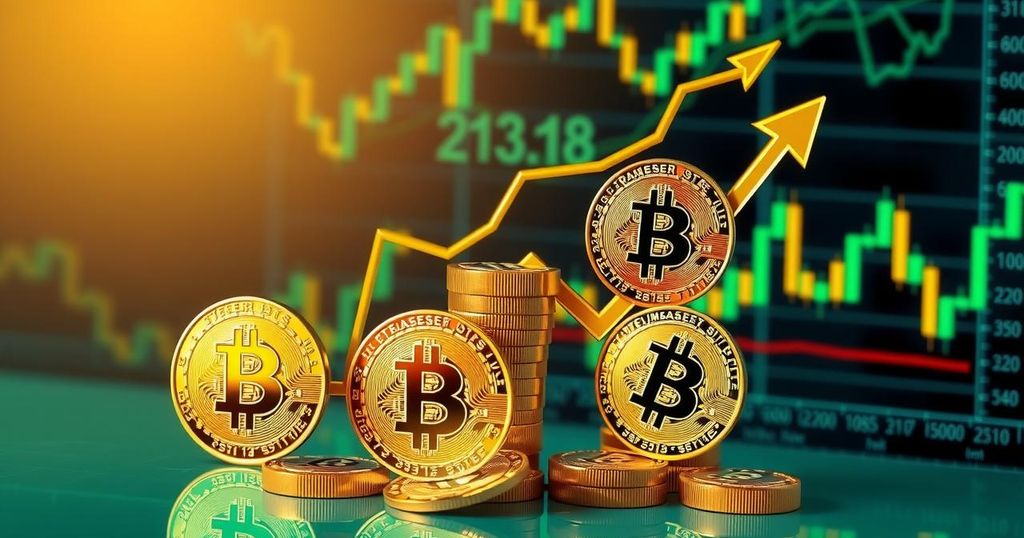Bitcoin’s Surge Driven by Wall Street Inflows and Declining Dollar
Bitcoin’s astonishing rise, now topping $122,000, reflects huge investments from Wall Street, along with a backdrop of declining dollar value. Here’s a closer look at the market dynamics shaping this surge.
Bitcoin Rallies Amid Wall Street Investments
Bitcoin has seen an impressive surge of over 25% this year, reaching astonishing heights of more than $122,000 per coin, largely driven by significant inflows from Wall Street. This influx, tallying up to a remarkable $85 billion from various Bitcoin Exchange Traded Funds (ETFs) over the past year, isn’t just bumping up prices; it’s also contributing to a notable decline in Bitcoin’s volatility. The waning strength of the U.S. dollar adds to this dynamic, making Bitcoin seem like a more attractive investment for many.
Crypto’s Leap Compared to Traditional Markets
Since its low point in April, the equity markets have rebounded robustly, with a historic bull rally taking shape. For reference, the S&P 500 has climbed a respectable 6.58% this year. However, this growth pales in comparison to Bitcoin’s performance, which achieved new record highs just yesterday. Following that peak, Bitcoin did dip just over 2% this morning as traders took profits, but the cryptocurrency remains significantly up on its year-to-date performance, showcasing its resilience despite the recent drop.
Decreasing Volatility Affects Market Confidence
Interestingly, Bitcoin’s impressive ascent has occurred with lower volatility than we’ve seen in its previous cycles. Some analysts point to factors like the regulatory backing from the former Trump administration as contributing elements to this trend. However, Marion Laboure and Camilla Siazon of Deutsche Bank pinpoint the primary reason as a substantial influx of traditional liquidity from the financial sector, which is driving Bitcoin’s current rally, as mentioned in a note reviewed by Fortune.
Inflows Into Bitcoin ETFs Reach New Heights
The figures behind this influx are staggering. For example, Wall Street funds reported an astonishing $35 billion inflow from new Bitcoin ETFs in just 2024 alone, with an additional $50 billion reported in the current year. Notably, last Thursday was a particularly lucrative day, with a single-day inflow of $1.17 billion into U.S. Bitcoin ETFs. BlackRock’s iShares Bitcoin Trust stands out, boasting $80 billion in assets despite being less than two years old, a milestone that took the SPDR Gold Shares ETF 15 years to achieve.
The De-Dollarisation Trend’s Impact
Furthermore, one cannot overlook the broader economic context. The U.S. dollar has declined by almost 10% against foreign currencies this year, as observed using the DXY index, prompting investors to search for alternative stores of value. According to the analysts, the signing of the latest tax bill is locking in ongoing deficits of around 6.5% to 7% of GDP for the foreseeable future. This has instigated a trend toward de-dollarisation, pushing investors into alternative assets such as gold and Bitcoin.
Market Movements and Expectations Ahead
As the trading day begins, the financial landscape appears active. The release of an update on the Consumer Price Index is expected at 8.30 a.m. ET, with analysts predicting an increase from the current rate of 2.4% up to 2.7%. In premarket trading, S&P 500 futures ticked up by 0.31%, reflecting a positive outlook after a gains of 0.65% on the previous day. Meanwhile, Asian and European markets were showing their own signs of recovery, with Hong Kong’s Hang Seng rising 1.6% and Japan’s Nikkei 225 gaining 0.55%. Bitcoin, however, saw a decrease of 2.56%, resting near $116,000.
In summary, Bitcoin is experiencing significant growth driven by ample inflows from traditional finance, reducing its volatility and attracting more investors. As the U.S. dollar declines and inflation concerns rise, many are gravitating towards cryptocurrencies as alternative assets. With the markets poised for more developments, Bitcoin’s record highs might just be the beginning of a broader trend in financial diversification.




Post Comment